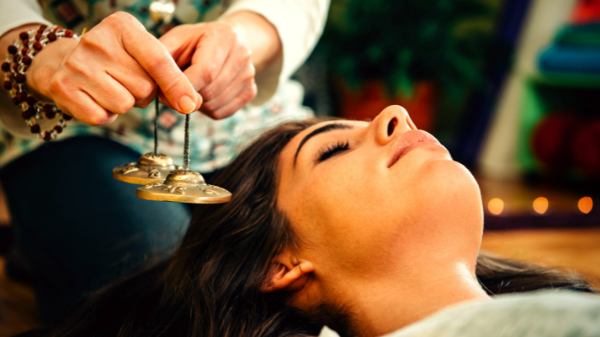Every wellness aficionado has surely listened to the many tones of the singing crystal bowl during a sound bath. The modish wellness practice envelops you in other-worldly sounds to ignite bodily and spiritual healing through sonic vibration. Shutting out the voices in your head, the sounds of your surroundings and indeed throughout the cosmos, the therapist rubs a small mallet around the edge of instruments like bowls and gongs to produce meditative sounds as you lie on your back.

At some point, the bowls are placed on your body so it can absorb the gentle chimes and calming vibrations. Unlike a massage, this hour-long session of stillness doesn’t do anything for sore muscles, but it’s a moment of pure zen, lifting spirits, calming the mind and leaving you as invigorated as after – if you’ll excuse the pun – a sound night’s sleep. From trendy meditation studios to intimate spas and Kendall Jenner’s home, the ritual is all the rage, and while its reputation is more woo-woo than science, purists believe the healing goes much deeper than just those feel-good mental-health moments.
Vibrational Healing

Mona Choi, a sound healer at Balance Health in Central, says that sound work has been around “since the beginning of time”. Thanks to celebrity endorsements from the likes of Robert Downey Jr., the Kardashians and Charlize Theron, singing bowls are having a wellness moment, but indigenous tribes around Asia have used them for healing and shifting the body’s energies for centuries – though they probably didn’t take selfies during the session.
Holistic healing is said to ‘wash over you’ – hence the name ‘sound bath’ – with chimes, vibrations and different frequencies cocooning people in a deep state of meditation. Group classes focus on relaxation, while bespoke one-on-ones can be self-reflective, therapeutic journeys that work on chronic stress and anxiety.
“I weave sound frequencies from all distances and directions to create crescendos,” says Choi, a certified therapist with over 15 years of experience. “As the vibration enters your brainwaves, the effect is multi-layered, active and very positive. The experience allows you to detach, relax and essentially find space for a new level of harmony.”
Garden of Zen

Energy flows where attention goes, and for many, a sound-healing session acts as a way to flow awareness towards one single point in order to meditate – something similar to breathwork in yoga or chanting.
Hasanal Lythgoe-Zafrullah, founder of mental health and wellness clinic Mindish, says that the idea is not to be whisked away to another dimension but to get reconnected to oneself as a vibrating being in motion. “Many people think that meditation is about calming the mind or being in a particular space. No, it’s about being in the body, and the mind follows,” he opines.
“Some people are not able to meditate or reap any benefits because they’re too aware, too conscious in the moment. When you do that, you’re not really meditating anymore. From a therapeutic point of view, sound healing comes down to listening to vibrations; the voice work of a teacher slows everything around you and creates an empty space.”
Music & Voice

Whether Mozart or Motown, Bach or Bieber, music elicits a variety of reactions in our mind and body, impacting us in different ways, but on a basic level, all music is just organised sound. Sound healing aims for the same – deconstructing music into pure tuneful sound and allowing it to channel our emotions, anxieties and energies.
Dipping into her two decades of therapeutic experience, Mindish’s Head of Wellness Surj Bahra uses her voice – talking and singing – to induce relaxation in her sessions. She notes that the sound of the crystal bowls can sometimes be unfathomable or peculiar, but “the soothing voice of the therapist is a really powerful instrument in guiding clients to a calm state”.
Some attendees are so immersed in the soundscape that they feel as light as a floating cloud; others report feeling heavy, almost merging with the ground on which they lie – but almost everyone experiences a noticeable shift in spatial awareness.
Sound Science?

Sound healing carries a somewhat woo-woo reputation (it’s right up there with crystal healing), and the lack of regulations and proliferation of unqualified practitioners with lofty claims don’t help, but there is some science to back this ancient healing therapy.
A 2016 observational study on Tibetan singing bowls found that the practice helps to lower blood pressure, improve breathing and blood circulation, and relieve chronic aches and pains. Matching the frequencies of the singing bowls with your body is said to slow down the heart rate and helps the brain move from a beta-dominant or focused state to more relaxed, alpha-dominant frame of mind.
Don’t expect an instant cure-all, though. As Balance Health’s Choi says, “Clarity, pure consciousness and an end to your emotional problems are not a one-hour job, but even a single session can be a journey to enlightenment where your problems are clearly defined or understood differently.”
Everyone has a different experience in a sound bath, but for this novice, an hour-long session felt like my body was cleansed and bereft of all thought. It was an unusually profound, noise-less state of being – somewhere between hypnotherapy and a calm afternoon at the beach. If it weren’t for my characteristic scepticism, I might add that it felt like my chakras were aligned. Well, almost.
(Text: Nikita Mishra Photos: Mindish, Hong Kong)



